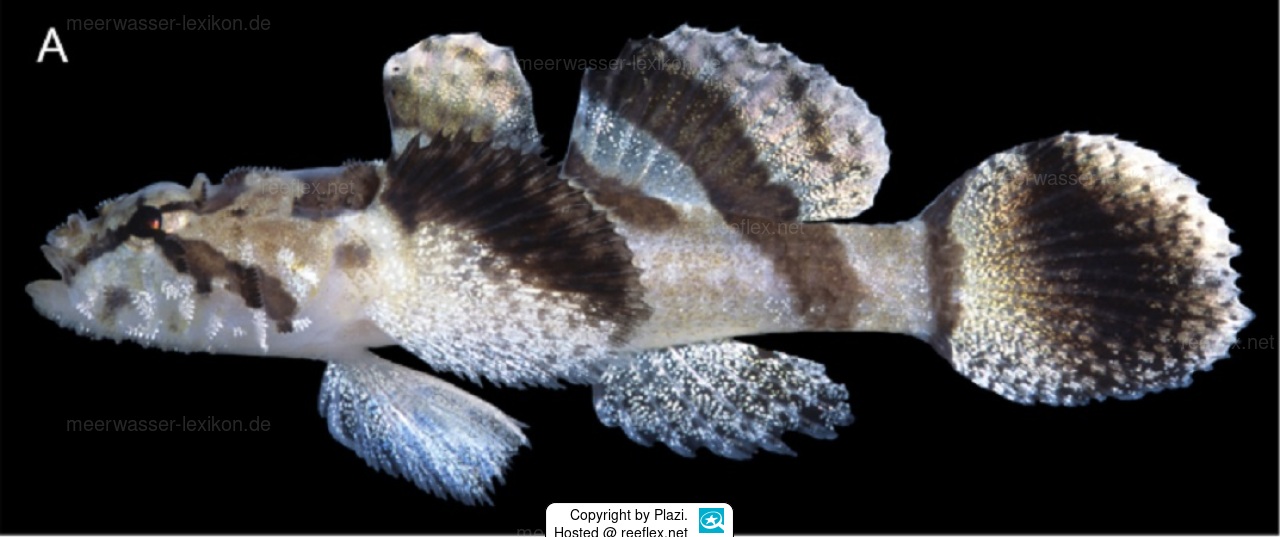Info
The goby Callogobius falx is currently known only from southern Japan and Luzon, Philippines.
In Japanese waters, the species has been recorded from Hachijo Island (Izu Islands), Kashiwa Island (Shikoku), Kakeroma and Okinoerabu Islands (Amami Islands), Okinawa, Ie and Kume Islands (Okinawa Islands), and Ishigaki and Yonaguni Islands (Yaeyama Islands) at depths ranging from 12-22 m.
The body of the goby is white with three oblique black bars that slope upward in front and are associated with the black bars of the dorsal fins.
The foremost bar extends from the top of the first spine of the first dorsal fin to the midline of the body through the middle of the first dorsal fin attachment.
The middle bar is short and extends from the lower part (including the base) of the first spine of the second dorsal fin to the dorsal surface of the body, the posterior tip extending to just below the fifth (fourth) soft ray of the dorsal fin. The width of this bar is slightly less than that of the anterior bar and is equal to the diameter of the pupil of the eye.
The rearmost bar is broad (width equal to eye diameter) and extends from the anterodorsal margin of the second dorsal fin to the middle region of the caudal peduncle through the posterior portion of the second dorsal fin attachment (the bar tapers posteriorly and kinks at the middle of the caudal peduncle.
There is a small, poorly defined black spot above the origin of the anal fin (not present on the animal in the first photo!).
All fins are white basally, the posterior margins of the vertical fins, except the caudal fin, have small, faint black spots (spots are absent on the first dorsal fin margin, which is brownish-yellow).
The upper half of the pectoral fin is broad (about 1/2 the length of the rays) and edged with black.
The caudal fin base shows a narrow, black, sickle-shaped bar and a large, poorly defined black spot (about 1/2 the size of the fin) in the middle of the caudal fin. .
Etymology.
The specific name falx, a Latin noun meaning "sickle," refers to the characteristic narrow bar at the base of the caudal fin of the new species.
Jumping guard
A jumping guard prevents (nocturnal) fish from jumping out.
Wrasses, blennies, hawkfishs and gobies jump out of an unprotected tank in fright if their night rest is disturbed, unfortunately these jumpers are found dried up in the morning on carpets, glass edges or later behind the tank.
https://www.korallenriff.de/en/article/1925_5_Jump_Protection_Solutions_for_Fish_in_the_Aquarium__5_Net_Covers.html
A small night light also helps, as it provides the fish with a means of orientation in the dark!
In Japanese waters, the species has been recorded from Hachijo Island (Izu Islands), Kashiwa Island (Shikoku), Kakeroma and Okinoerabu Islands (Amami Islands), Okinawa, Ie and Kume Islands (Okinawa Islands), and Ishigaki and Yonaguni Islands (Yaeyama Islands) at depths ranging from 12-22 m.
The body of the goby is white with three oblique black bars that slope upward in front and are associated with the black bars of the dorsal fins.
The foremost bar extends from the top of the first spine of the first dorsal fin to the midline of the body through the middle of the first dorsal fin attachment.
The middle bar is short and extends from the lower part (including the base) of the first spine of the second dorsal fin to the dorsal surface of the body, the posterior tip extending to just below the fifth (fourth) soft ray of the dorsal fin. The width of this bar is slightly less than that of the anterior bar and is equal to the diameter of the pupil of the eye.
The rearmost bar is broad (width equal to eye diameter) and extends from the anterodorsal margin of the second dorsal fin to the middle region of the caudal peduncle through the posterior portion of the second dorsal fin attachment (the bar tapers posteriorly and kinks at the middle of the caudal peduncle.
There is a small, poorly defined black spot above the origin of the anal fin (not present on the animal in the first photo!).
All fins are white basally, the posterior margins of the vertical fins, except the caudal fin, have small, faint black spots (spots are absent on the first dorsal fin margin, which is brownish-yellow).
The upper half of the pectoral fin is broad (about 1/2 the length of the rays) and edged with black.
The caudal fin base shows a narrow, black, sickle-shaped bar and a large, poorly defined black spot (about 1/2 the size of the fin) in the middle of the caudal fin. .
Etymology.
The specific name falx, a Latin noun meaning "sickle," refers to the characteristic narrow bar at the base of the caudal fin of the new species.
Jumping guard
A jumping guard prevents (nocturnal) fish from jumping out.
Wrasses, blennies, hawkfishs and gobies jump out of an unprotected tank in fright if their night rest is disturbed, unfortunately these jumpers are found dried up in the morning on carpets, glass edges or later behind the tank.
https://www.korallenriff.de/en/article/1925_5_Jump_Protection_Solutions_for_Fish_in_the_Aquarium__5_Net_Covers.html
A small night light also helps, as it provides the fish with a means of orientation in the dark!







 Plazi
Plazi

















